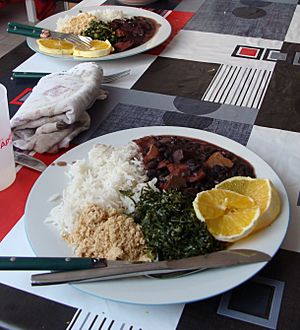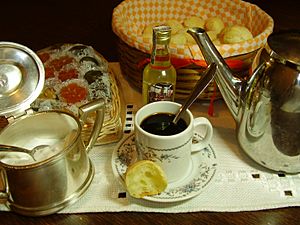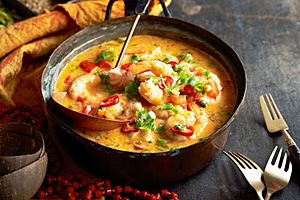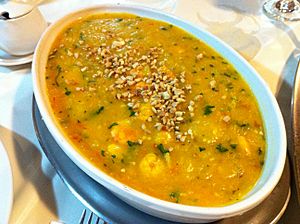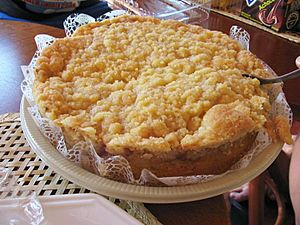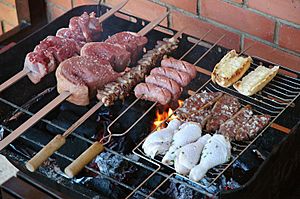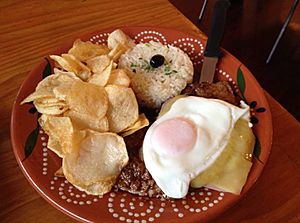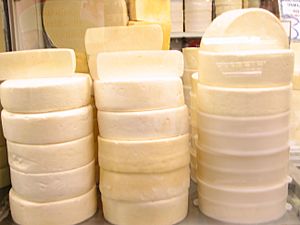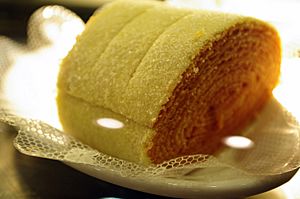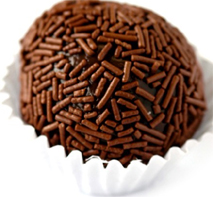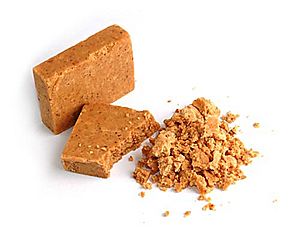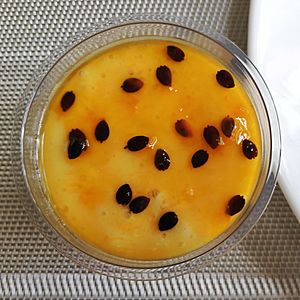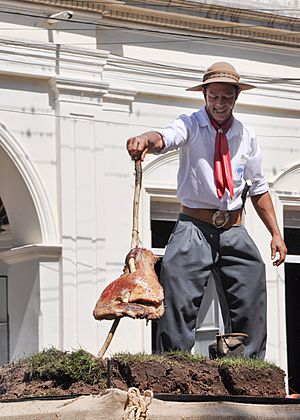Brazilian food facts for kids
Brazilian cuisine is a mix of cooking styles and traditions from Brazil. It's known for its many influences from Europe, Amerindian people, Africa, and even Asia (like Lebanese, Chinese, and Japanese dishes). Because Brazil is so big and has so many different people, its food changes a lot from one region to another. This means Brazil has a national cuisine that celebrates its many regional differences.
Native peoples in Brazil first used ingredients like cashews, cassava, guaraná, açaí, cumaru, and tucupi. Later, many groups of immigrants brought their own dishes. They often used local ingredients when their usual ones weren't available. For example, European immigrants (mostly from Portugal, Italy, and Germany) were used to eating wheat. They brought wine, leafy vegetables, and dairy products to Brazil. When they couldn't find potatoes, they learned to use native sweet manioc instead. Enslaved Africans also helped create Brazilian cuisine, especially in the coastal states. Even later immigrants, like Japanese people, brought many of the Asian foods Brazilians enjoy today.
Some of the most famous regional foods come from the states of Minas Gerais and Bahia. Minas Gerais cuisine shows European influences with tasty dairy products like feijão tropeiro, pão de queijo (cheese bread), and Minas cheese. Bahian cuisine has strong African influences with dishes like acarajé, abará, and vatapá.
Common local ingredients include Root vegetables like manioc (also called mandioca or aipim), yams, and many fruits. These fruits include açaí, cupuaçu, mango, papaya, guava, orange, passion fruit, pineapple, and hog plum.
Some well-known Brazilian dishes are feijoada, which is seen as the country's national dish. Other regional favorites include beiju, feijão tropeiro, vatapá, moqueca capixaba, polenta (from Italian cooking), and acarajé (from African cooking). There's also caruru, made with okra, onion, dried shrimp, and toasted nuts, cooked in palm oil. Moqueca baiana is slow-cooked fish in palm oil and coconut milk with tomatoes, bell peppers, onions, garlic, and cilantro.
Brazil's national drink is coffee. Cachaça is a Brazilian liquor made from fermented sugar cane juice. It's the main ingredient in the national cocktail, caipirinha.
Cheese buns (pão-de-queijo) and salgadinhos are popular finger foods. These include pastéis, coxinhas, risólis, and kibbeh (from Arabic cooking). Cuscuz de tapioca (made from milled tapioca) is a popular dessert.
Contents
Brazilian Food by Region
Different Regional Cuisines

There isn't just one "national Brazilian cuisine." Instead, there are many different regional traditions and dishes. This variety comes from the different people who settled in each area.
For example, the food in Bahia is strongly influenced by African, Indigenous, and Portuguese cooking. Chili (and chili sauces) and palm oil are very common there. In the northern states, where there are many forests and rivers, fish, fruits, and cassava (including cassava flours) are main foods. In the deep south, like in Rio Grande do Sul, the food is more like the gaúcho traditions shared with Argentina and Uruguay. This region has many meat dishes because of its livestock farming. The churrasco, a type of barbecue, is a local tradition.
Southeast Brazil's Food
In Rio de Janeiro, São Paulo, Espírito Santo, and Minas Gerais, feijoada is very popular, especially for lunch on Wednesdays or Saturdays. Picadinho (diced meat) and rice and beans are also eaten often. In Rio de Janeiro, besides feijoada, a popular meal is grilled beef fillet with rice, beans, farofa, fried garlic, and fried potatoes. This is often called filé à Osvaldo Aranha. Seafood is popular in coastal areas, as is roasted chicken (galeto). The strong Portuguese influence also brought bolinhos de bacalhau (fried cod fritters), which are common street foods.
In São Paulo, a typical dish is virado à paulista. It's made with rice, a bean paste called virado de feijão, sauteed kale, fried plantains or bananas, and pork chops. São Paulo is also known for pastel, which are thin pastry pockets filled with different ingredients and deep-fried. Many believe they came from Chinese and Japanese immigrants who changed spring roll recipes to sell as snacks. São Paulo is also famous for parmegianna.
In Minas Gerais, regional dishes include corn, pork, beans, and chicken. A very typical dish is frango com quiabo (chicken with okra). Other favorites are tutu de feijão (puréed beans mixed with cassava flour) and local soft traditional cheeses.
In Espírito Santo, Italian and German influences are strong in both savory and sweet dishes. The state's main dish, though, is of Amerindian origin: moqueca capixaba. This is a tomato and fish stew traditionally cooked in a special clay pot. Seafood dishes are very popular in Espírito Santo, and unlike some other Amerindian dishes, olive oil is almost always used. Bobó de camarão, torta capixaba, and polenta are also very popular.
North Brazil's Food
The food in this region (which includes states like Acre, Amazonas, and Pará) is heavily influenced by indigenous cooking. In the state of Pará, there are several unique dishes, such as:
Pato no tucupi (duck in tucupi) – This is one of the most famous dishes from Pará. It's often eaten during the Círio de Nazaré, a local Catholic celebration. The dish is made with tucupi, a yellow broth from cassava. The duck is cut into pieces and boiled in this sauce. A plant called jambu is also added. It's usually served with white rice and cassava flour tortillas.
Center-West Brazil's Food
In Goiás State, the pequi fruit is used in many typical foods, especially arroz com pequi (rice cooked with pequi). It's also used as a filling for pastel. Chestnuts and palm trees are common here. A mix of chicken and rice called galinhada is also very popular. The states of Mato Grosso and Mato Grosso do Sul have food influenced by neighboring countries. The Pantanal area, with its many rivers and wetlands, means there's a lot of fish in the cuisine of these two states.
Northeast Brazil's Food
Northeastern Brazilian food is strongly influenced by African cooking from coastal areas like Pernambuco and Bahia. It also includes the eating habits of indigenous people who lived in the region.
The vatapá is a Brazilian dish made from bread, shrimp, coconut milk, finely ground peanuts, and palm oil, all mashed into a creamy paste.
The bobó de camarão is a dish made with cassava and shrimp.
The acarajé is made from peeled black-eyed peas shaped into a ball and deep-fried in dendê (palm oil). It's often sold as street food, cut in half and filled with vatapá and caruru. You can find acarajé outside Bahia too.
In other areas, further west or away from the coast, the dishes are more like indigenous cuisine. Many vegetables have been grown there since before the Portuguese arrived. Examples include baião de dois, made with rice and beans, dried meat, butter, queijo coalho, and other ingredients. Jaggery (a type of unrefined sugar) is strongly linked to the Northeast, as are carne-de-sol (sun-dried meat), paçoca de pilão, and bolo de rolo (roll cake).
Tapioca flatbreads or pancakes are often served for breakfast in some states. They can be filled with coconut, cheese, condensed milk, butter, or certain meats. They can also have sweet dessert fillings.
Southern Brazil's Food
In Southern Brazil, red meat is the main part of the local food. This is because of the long tradition of livestock farming and the many German immigrants.
Besides many pasta, sausage, and dessert dishes common in Europe, churrasco is the word for a barbecue that started in southern Brazil. It includes many types of meat cooked on a special barbecue grill, often with skewers. Portable churrasqueiras are similar to those used in Argentina and Uruguay. The meat can also be cooked on large metal or wood skewers over charcoal embers.
Because gaúchos (cowboys) were nomadic and lived off the land, they couldn't preserve food easily. They would gather after butchering a cow, skewer large pieces of meat, and cook them right away over a wood fire. This slow cooking made the meat tender and flavorful. This style has inspired many modern churrascarias, where waiters bring large cuts of roasted meat to your table and carve portions for you.
The chimarrão is the regional drink, often linked to the gaúcho image.
The most typical dishes of Rio Grande do Sul are churrasco, chimarrão, carreteiro rice (cowboy rice), fried polenta, galeto (small roasted chicken), cuca (a type of cake), and sagu (tapioca pearls). This region also has a lot of wine, grape juice, and white grape juice because it's the biggest grape producer in Brazil. Homemade cheeses and salamis are also common. Jellies and jams made from fig, grape, and peach are very popular. One famous one is chimia. Eating vegetables preserved in water, vinegar, sugar, salt, and spices, like beets and cucumbers, is also typical in the Southern Region.
Popular Snacks
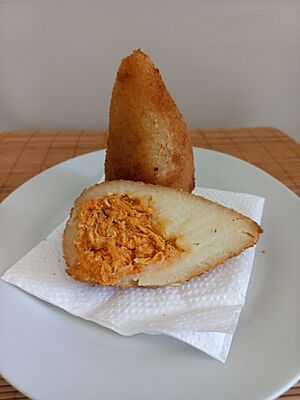
Salgadinhos are small savory snacks. They are often sold in small shops and are a common food at family parties. There are many types of pastries:
- Pão de queijo (meaning "cheese bread") is a typical Brazilian snack. It's a small, soft roll made from manioc flour, eggs, milk, and Minas cheese. You can buy it ready-made or frozen to bake at home. It's also gluten-free.
- Coxinha is a chicken croquette shaped like a chicken thigh.
- Pastéis (one is a pastel) are pastries with many different fillings. They are similar to Spanish fried Empanadas but came from Asia. It's believed that Chinese and Japanese immigrants adapted spring rolls to sell as snacks. Different shapes are used to show different flavors, like half-moon for cheese and square for meat. They can be filled with meat, cheese, chicken, heart of palm, shrimp, chocolate with banana, or cheese with guava paste.
- Bolinhos de bacalhau are fried cod fish pastries. They are found mostly in Rio de Janeiro but also in other parts of Brazil.
- Empadas are small snacks that look like tiny pot pies. They can be filled with hearts of palm, shrimp, chicken, and cheese.
- Quibe (also spelled Kibe) is very popular. It's the same as the Lebanese dish kibbeh and was brought to Brazil by Syrian and Lebanese immigrants. It can be baked, fried, or eaten raw.
- Esfiha (also spelled Esfirra) is another Middle Eastern dish. Even though it's a newer addition to Brazilian food, it's now easy to find everywhere, especially in the Northeast, South, and Southeast regions. They are pies or cakes with fillings like beef, mutton, cheese curd, or seasoned vegetables.
Other appetizers you can find in Brazil include croquettes, rissoles, coxa-creme, cueca virada, and bolinho de aipim (cassava pastries).
Popular Dishes
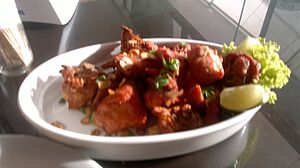
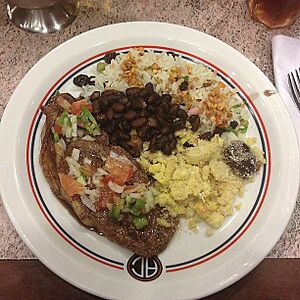
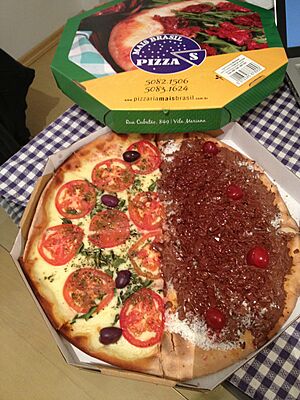
Brazilian food is known worldwide for its variety and quality. The city of São Paulo was named the 7th best food destination globally because of its great restaurants and bars. São Paulo alone has over 9,000 restaurants and bars.
- Rice and beans is an extremely popular and basic dish in Brazil, a tradition shared with many Caribbean countries. Brazilian rice and beans are usually cooked with lard or, more commonly today, vegetable oils. They often use a cooking method called refogado, which usually includes garlic.
- Instead of rice and beans, Brazilians sometimes eat pasta (like spaghetti, lasagne, lamen), pasta salad, or dishes with potatoes or manioc. Polenta is also used instead of rice. Salads, dumplings, or soups made from green peas, chickpeas, black-eyed peas, broad beans, butter beans, soybeans, lentils, moyashi, and azuki beans are also common. These substitutions are more common during holidays like Christmas and New Year's Eve (lentils are traditional). They are also eaten after a churrasco (often with potato salad or carrot salad called maionese, using mayonnaise) and on other special occasions.
- The base of daily Brazilian cooking is usually a starch (like a cereal), a legume, a protein, and vegetables.
- Churrasco is the main dish of southern Brazil. Over time, other regions in Brazil adopted churrasco and found new ways to make it. A restaurant that specializes in churrasco is called a churrascaria.
- Picanha is a special cut of meat that is very popular in Brazil.
- Farofa is cooked cassava flour that is served as a side dish or condiment. People especially like its crunchy texture.
- Bife à cavalo: a steak topped with a fried egg, usually served with French fries and sometimes salad.
- Bife à parmegiana: a fried steak, breaded with wheat flour and eggs, topped with parmesan cheese and lots of tomato sauce. Sometimes mozzarella is used instead of parmesan. Even though this dish was created in Brazil, it's often thought of as an Italian recipe in the country.
- Virado, a typical dish from São Paulo, also known as Virado à Paulista. It includes a pork chop, fried plantain, cassava flour beans, rice, cabbage, and a fried egg.
- Tutu de feijão, a typical dish from Minas Gerais. It's made with boiled beans, sautéed and thickened with cassava or corn flour. It's often cooked with fried bacon, onion, and garlic.
- Arroz carreteiro is a typical dish from southern Brazil. It's made with rice and finely chopped or shredded dried meat, sometimes with sausage, bacon, and chorizo. It's cooked with garlic, onion, tomato, and parsley.
- Galinhada is a typical dish from São Paulo, Minas Gerais, and Goiás. It's made with cooked rice and cooked chicken pieces. It's seasoned with saffron (which gives the rice a yellow color) and sometimes served with vinaigrette and bean tutu. The Goiás version often includes guariroba (a bitter palm) and pequi.
- Barreado is a typical dish from Parana State. It's a slow-cooked meat stew prepared in a clay pot. The lid is sealed with a clay-like paste made from wheat or cassava flour, which is where the name "barreado" (meaning "muddied") comes from. Traditionally, it was made with buffalo meat, but now it's usually beef, bacon, tomatoes, onion, cumin, and other spices. It's cooked slowly for 12 to 18 hours.
- Pizza is also very popular. It's usually made in a wood-fired oven with a thin crust and little sauce. Brazilian pizzas can have over 100 flavors, both savory (like calabresa sausage, pepperoni, egg, chicken, catupiry cheese, tuna, onion, or even hamburger or sushi) and sweet (like chocolate, banana with cinnamon, goiabada with cheese, fig, or even ice cream scoops and M&Ms). Olive oil is often poured over pizza, but in some regions, people use ketchup, mustard, or even mayonnaise.
- Cachorro quente is the Brazilian version of hot dogs. This dish has been changed in Brazil to become almost a full meal. The most common version is the "X-Tudo" (meaning "cheese-everything") or "Podrão." Besides the usual bread and sausage with ketchup, mustard, and mayonnaise, it's filled with many extra ingredients like straw fries, grated Parmesan cheese, corn, peas, olives, and even quail eggs.
- Misto-quente is a grilled ham and cheese sandwich.
- Angu is a popular side dish, similar to Italian polenta. It's common in Southern and Southeastern Brazil.
- Arroz com pequi is a traditional dish from the Brazilian Cerrado region and a symbol of Center-Western Brazil's food. It's mainly rice seasoned with pequi (a type of nut) and often chicken.
- Cuscuz branco is a dessert made from milled tapioca cooked with coconut milk and sugar. It's like a couscous version of rice pudding.
- Açaí, cupuaçu, carambola, and many other tropical fruits are sent from the Amazon Rainforest and used in smoothies or eaten fresh. Other foods from Amazonian cuisine are also becoming popular.
- Pinhão is the pine nut from the Araucaria angustifolia tree, common in southern Brazil's highlands. The nuts are boiled and eaten as a snack in winter. They are often eaten during the festas juninas (June festivals).
- Risoto (risotto) is an Italian rice dish cooked with chicken, shrimp, seafood, or other proteins, sometimes with vegetables. It's very popular in Southern Brazil due to many Italian immigrants.
- Mortadella sandwich is very common in São Paulo because of Italian immigration.
Other notable foods include:
- Special ethnic foods and restaurants are common in Brazil, like Arab cuisine (Lebanese and Syrian), local versions of Chinese cuisine, Italian cuisine, and Japanese cuisine. Sushi bars are found in major cities. People in Rio de Janeiro are more used to temaki (hand rolls) than those in São Paulo, where most Japanese Brazilians live.
- Brazil nut cake is a common cake in the Amazon region of Brazil, Bolivia, and Peru.
- Broa, a type of cornbread with fennel.
- Pirão, a porridge-like dish made of manioc in fish stock.
Brazilian Cheeses
Brazil produces several types of cheese that are unique to the country. Their qualities change depending on the state, mainly due to the climate, soil, and what the cows eat. The state of Minas Gerais, known for its dairy farms, produces most of these cheeses. Some are considered among the best cheeses in the world. Here are some of Brazil's most famous cheeses:
- Minas, also called "white cheese," is light and often chosen by people who want a healthier diet. It's usually sold in water.
- Catupiry is a creamy cheese invented in Minas Gerais. It's mainly used as a topping or filling for pizzas. It's a soft, processed cheese sold in a special round wooden box.
- Requeijão: a slightly salty, smooth, spreadable cheese sold in glass jars and eaten on bread. There are different kinds of Brazilian requeijão. The "Requeijão de Corte" is the oldest, a solid, handmade type. "Requeijão Cremoso" is the most common today; it's a creamy, white dairy product made with skimmed milk and fresh cream. It's usually sold in cups and spread on bread for breakfast. "Requeijão Culinário" is a thicker creamy cheese designed to stay firm when cooked at high temperatures.
- Canastra
- Coalho is a heat-resistant cheese, meaning it can be cooked and grilled. It's often eaten at beaches or barbecues, roasted on skewers over a fire.
Drinks
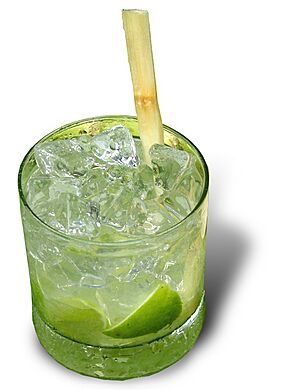
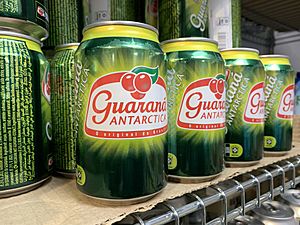
Cachaça is Brazil's native liquor, made from sugar cane. It's the main ingredient in the national drink, the Caipirinha. Other drinks include mate tea, chimarrão and tereré (both made from yerba maté), coffee, fruit juice, beer (mostly Pilsen type), rum, guaraná, and batidas. Guaraná is a caffeinated soft drink made from guaraná seeds. A batida is a type of fruit punch.
Other drinks include:
- Água de Coco – coconut water.
- Caldo de cana – sugarcane juice.
- Aluá – made with maize, rice, and sugar. It's also called corn wine.
- Bombeirinho – made with cachaça and gooseberry syrup, similar to a Kir Royal cocktail.
- Cachaça – a distilled spirit from sugarcane juice. It's Brazil's most popular alcoholic drink.
- Caipirinha – a cocktail with cachaça, lime juice, and sugar.
- Caju Amigo – a cocktail with cachaça and cashew juice.
- Cashew juice – a juice made from the cashew apple. Other popular Brazilian juices are made from maracujá, goiaba, acerola, and graviola.
- Licor de jabuticaba – a liqueur made with jabuticaba fruit.
- Capeta – a cocktail with vodka, guaraná powder, and sweet skim milk.
- Chá mate gelado – roasted erva mate (Ilex paraguariensis) iced tea. Popular in homes and Rio de Janeiro, sold on its beaches.
- Chimarrão and Tererê – drinks made from dried leaves of yerba mate.
- Guaraná – soft drink from the Guaraná plant.
- Limonada suíça – made with lime pieces (with peel), ice, sugar, and water. A version with condensed milk is also popular.
- Quentão
- Rabo-de-galo – a cocktail with cachaça and red vermouth.
- Tiquira – a cachaça drink made with manioc.
- Vinho Quente – hot mulled wine, popular in winter.
Popular Desserts

Brazil has a tradition of making jams and jellies from fresh tropical fruits. Brazil is known worldwide as a country with great food production and is one of the largest food exporters. Brazilians learned about sugar from the Portuguese who immigrated to Brazil. In the kitchens of sugar farms, farmers' wives taught how to mix ingredients correctly. This led to more sweets being sold in Brazil. Portuguese recipes spread throughout the colony and became part of the local food.
The Portuguese tradition of making sweets with eggs and sugar combined with Brazil's huge variety of tropical fruits. This created many delicious treats. Brazil has many candies like brigadeiros (chocolate fudge balls), cocada (a coconut sweet), beijinhos (coconut truffles with a clove), and Romeu e Julieta (cheese with a guava jam called goiabada).
Peanuts are used to make paçoca, rapadura (a type of unrefined sugar), and pé-de-moleque. Common local fruits like açaí, cupuaçu, mango, papaya, cocoa, cashew, guava, orange, passionfruit, pineapple, and hog plum are made into juices, chocolates, ice pops, and ice cream.
Typical Cakes (bolos)
- Pavê
- Cuca, a cake made with eggs, wheat flour, and butter, topped with sugar. It's very similar to Streuselkuchen, a German cake. It's typical in the southern region of Brazil.
- Nega maluca (chocolate cake with chocolate frosting and chocolate sprinkles)
- Pão de mel (honey cake, like gingerbread, usually covered with melted chocolate)
- Bolo de rolo (roll cake, a thin cake rolled with melted guava)
- Bolo de cenoura (carrot cake with chocolate frosting made with butter and cocoa)
- Bolo prestígio (cake covered with a version of brigadeiro that uses grated coconut instead of cocoa powder)
- Bolo de fubá (corn flour cake)
- Bolo de milho (Brazilian-style corn cake)
- Bolo de maracujá (passion fruit cake)
- Bolo de mandioca (cassava cake)
- Bolo de queijo (meaning "cheese cake")
- Bolo de laranja (orange cake)
- Bolo de banana (banana cake with cinnamon drizzle)
Other Popular Desserts
- Brigadeiro (a Brazilian chocolate candy, considered the most typical dessert. It's a type of truffle made of condensed milk, butter, and cocoa powder.)
- Paçoca (similar to Spanish polvorones, but made with peanuts and no added fats)
- Quindim (egg custard with coconut)
- Cocada (coconut sweet)
- Beijinho (coconut "truffles" with a clove)
- Cajuzinho (peanut and cashew "truffles")
- Pudim de leite (condensed milk-based crème caramel, from France)
- Doce de leite
- Goiabada
- Olho-de-sogra
- Pé-de-moleque (made with peanuts and caramel sugar)
- Sagu
- Mousse de maracujá
- Queijadinha
- Creme de papaya
- Maria-mole
- Pamonha (a traditional Brazilian food made from fresh corn and milk, wrapped in corn husks and boiled. It can be savory or sweet.)
- Rapadura
- Curau
- Canjica
- Torta holandesa (Dutch pie)
- "Açaí na tigela" (usually a mix of açaí (a Brazilian fruit) with bananas and cereal, or strawberries and cereal, often granola.)
- Pudim de pão (meaning "bread pudding," a pie made with leftover bread soaked in milk, plus eggs and sugar, often with dried orange slices and clove)
- Manjar branco (coconut pudding with caramel sauce and dried plums)
- Arroz-doce (rice pudding)
- Torta de limão (meaning 'lime pie', a shortcrust pastry with creamy lime-flavored filling)
- Brigadeirão (a chocolate version of pudim de leite or a chocolate cake)
- Doce de banana or Bananada (different types of banana sweets, solid or creamy)
- Papo-de-anjo
- Avocado cream (avocado, lime, and powdered sugar; blended and chilled)
- Biscoito de polvilho (cassava starch biscuit)
- Sweets and preserves made from fig, papaya, mango, orange, citron, pear, peach, pumpkin, sweet potato, and more. These are often eaten with fresh cheese or doce de leite.
Daily Meals
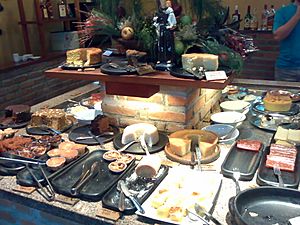
- Breakfast, called café-da-manhã (meaning "morning coffee"): Each region has its own typical breakfast. It's usually a light meal, sometimes just a fruit or a slice of bread with coffee. Common items include tropical fruits, cakes, crackers, bread, butter, cold cuts, cheese, requeijão, honey, jam, doce de leite, coffee (often sweetened with milk), juice, chocolate milk, or tea.
- Elevenses or brunch, called lanche-da-manhã (meaning "morning snack"): This is usually eaten between 9 and 11 AM and includes similar items to breakfast.
- Midday dinner or lunch, called almoço: This is usually the biggest meal of the day, eaten between 11 AM and 2 PM. Traditionally, people would go home to eat with their families. Today, many people eat lunch in groups at restaurants or cafeterias. Rice is a main part of the Brazilian diet, though pasta is sometimes eaten instead. It's usually eaten with beans and served with salad, protein (often red meat or chicken), and a side dish like polenta, potatoes, or corn.
- Tea, called lanche-da-tarde or café-da-tarde (meaning "afternoon snack" or "afternoon coffee"): This meal is eaten between lunch and dinner. People eat many of the same things as breakfast, but fruits are less common.
- Night dinner or supper, called jantar: For most Brazilians, jantar is a light meal. Others have a bigger dinner at night. Sandwiches, soups, salads, pasta, hamburgers or hot dogs, pizza, or leftovers from lunch are common dishes.
- Late supper, called ceia: Brazilians eat soups, salads, pasta, and what they might eat for an elevenses if their jantar was light and early. This meal is often associated with Christmas and New Year's Eve.
Restaurant Styles
A simple and usually affordable choice, also good for vegetarians, is comida a quilo or comida por quilo restaurants (meaning "food by kilo"). These are buffets where you pay for your food by weight. Another common style is the all-you-can-eat restaurant, where you pay one price for unlimited food. In both types, called "self-services," you choose your food from a large buffet.
Rodízio is a common service style where you pay a set price, and servers bring food around to your table. This is popular in churrascarias (barbecue restaurants), pizzerias, and sushi restaurants. You can eat all the meat or different pizza slices you want.
A regular restaurant where each meal has a specific price is called a "restaurante à la carte."
Vegetarian Options
Even though many traditional dishes have meat or fish, it's not hard to find vegetarian food in Brazil, especially in mid-sized and larger cities. There are plenty of fruits and vegetables. On city streets, you can find cheese buns (pão de queijo), and in some cities, even a version made from soy.
In the 2000s, São Paulo, Rio de Janeiro, and Brasilia have seen many vegetarian and vegan restaurants open. However, outside big cities, vegetarianism is not very common. Not every restaurant will have vegetarian dishes, and some meals that seem vegetarian might have unwanted ingredients, like lard used for cooking beans. Often, "meat" is understood to mean "red meat," so some people might think a vegetarian eats fish and chicken. Comida por quilo and all-you-can-eat restaurants offer a wide range of fresh dishes, making it easier for people with special diets to find food.
See also
 In Spanish: Gastronomía de Brasil para niños
In Spanish: Gastronomía de Brasil para niños
- Culinary art
- Brazilian tea culture


